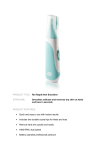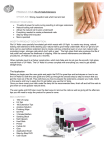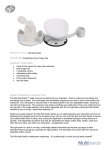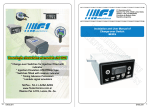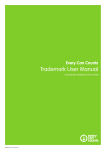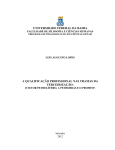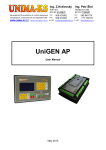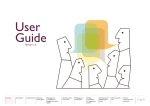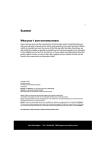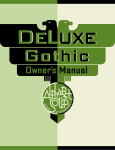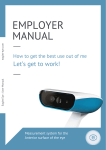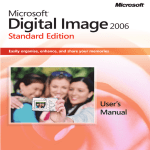Download OM logo User Guide 0606.indd
Transcript
Guidelines for use of the OM logo ������������� Table of contents Introduction ...........................................................3 Changes ...................................................................4 Typography ............................................................5 Strapline...................................................................6 Restrictions .............................................................8 Colour Scheme ................................................... 10 File Formats ......................................................... 12 Logo Packages on Caleb ................................. 13 Sample Letterhead ........................................... 14 Sample Envelope & Business Card .............. 15 Introduction 3 As OM continues to grow and diversify worldwide, it is increasingly important to strengthen our shared values and identity. Central to this aim is a commitment to faithful use of our branding and, in particular, our logo with its elements. This User Guide is designed to explain the changes to our logo, some of the technical issues involved, accepted best treatments of the logo, restrictions on how it may not be used and, above all, the necessity of universal adherence to these parameters throughout our organisation. OM is a fluid, adaptive organisation. The present logo follows others in our history and itself will likely be superceded in the future. However, working together today to achieve uniformity with this fresh identity will ensure that inevitable changes tomorrow will be met with confidence and success. Changes 4 After wide and lengthy discussion, the OM logo has been refreshed to reflect a new emphasis within our organisation. There are several changes: old bitmap • the original design was distributed as a scanned TIFF (bitmap) file—suitable for photos but inefficient for artwork. Rasterized files are large, scale poorly with distortion, and have transparency problems. Over time, individuals addressed this problem for their own purposes resulting in a wide variety of logos across the OM world. new vector The letterform itself has been slightly simplified: the ‘tail’ at the top of the ‘O’ has been removed and the closing top half of the ‘O’ is more proportionate to highlight the handwritten effect of the letterform. Simplified paths were created in a vector program, resulting in a significantly smaller file and a smoother shape that is scalable without distortion • the colour has been changed from magenta to a deep red (see examples above), excluding the use of any other colour except black, grey or white (specifications are given elsewhere in this guide). CMYK percentages [C=0, M=95, Y=75, K=5] and/or the PANTONE (PMS) 186C must be followed. See page 10 for details. • the name ‘Operation Mobilisation’ shall no longer be used in conjunction with the logo ����������� • each field’s name is allotted a defined space, and there may be different versions depending on national language Typography 5 All artwork components containing type are provided as line art. This means that no font is required to print the logo with a field name. ����������� However, if a design benefits from using the font elsewhere, it should be: URW Grotesk E Light Condensed. OM does not provide this font but it can be purchased (http://www.urwpp.de/cgi-bin1/dalcgi/source/ schnellsuche.htd?searchchar=grotesk) from the foundry for €29. It may also be part of a commercial font collection, or a freeware/shareware font may be an excellent match. A sample is given below: ABCDEFGHIJKLMNOPQRSTUVWXYZ abcdefghijklmnopqrstuvwxyz 1234567890 A comprehensive style guide for typography used in OM publications will be developed in the near future. Strapline 6 A strapline (or tagline) encapsulates the current vision or mission of an organisation and, as such, can bring focus to its activities. It defines (ideally) what the organisation does—and does not do. By definition, these emphases change over time, which is why it is essential to understand that, although a strapline may be used in conjunction with a logo, it can never be considered as part of a logo. The logo is a bedrock image statement that achieves recognition value over time. Thus, it should not undergo change as easily as straplines. The OM strapline of the 1990s (Bringing hope to the peoples of the world) has been replaced to reflect the new directions in ministry within OM. Our new international strapline is “transforming lives and communities”. Issues 1. Language. Translating the new strapline into some languages is problematic: either it becomes unwieldy in length, or concepts like transformation or communities miscommunicate. Using the English strapline with a native-language country name also looks awkward. 2. Localised emphasis in ministry. Some fields already employ a different strapline that serves them well and are in keeping with OM’s overall values. Forcing these to be dropped in favour of a single solution may be counterproductive. Recommendations 1. Freedom to choose. Using a strapline is encouraged and, wherever possible, ‘transforming lives and communities’ or a translation thereof is desirable. Otherwise, a more suitable phrase may be used. 2. Uniformity in design. When a strapline is used in proximity to the logo, it should adhere to the following typography, space and sizing requirements (next page). Strapline 7 Typography Recognizing that the use of a strapline will vary, a common font was chosen that would complement but not compete with the country name. The strapline font is Arial Bold Italic. Its size will depend on the size of the logo in any given document and the length of the strapline wording itself. letterform height gap x-height �������������� transforming lives and communities Spacing Using the example on this page to establish vertical spacing with the strapline, consider the three measurements involved: the height of the “O” in the letterform, the gap between it and the strapline, and the x-height (letter height not including ascenders or descenders) of the strapline itself. If, for example, in real terms the “O” is 37.5 mm, the gap is 5.35 mm and the x-height is 2.5 mm, then the gap is 1/7 of the “O” height and the x-height of the strapline text is 1/15 of the “O” height. (Whether picas, millimetres or inches, the ratio is the same). In practice, it is simple to achieve positioning visually using the example as a guide. Horizontally, the strapline should fill the width of the logo and country name but never exceed this width. If it is slightly less than the full width, it should be rightaligned with the right edge of the country name. Countries with short names (e.g. Canada or USA) may find it awkward to use the strapline as a single line since it will extend far beyond the country name. �������������� transforming lives and communities ����������� Minimum sizing The weakness of linking a strapline of small text to a logo becomes apparent when reducing the size of the logo: it quickly becomes illegible. Therefore, minimum height when using the strapline in proximity to the logo should not be less than 1” (2.5 cm). Without the strapline (or county name), it can be reduced to .5” (1.25 cm) although this will depend on background colour and overall design; often these will increase the minimum size for the sake of legibility. Restrictions 8 Clear Space Y In general, the minimum distance between the logo elements, other page content and the edge of a page should be one-half of the height of the logo. The preferred horizontal distance between the logo and any other page element is the width of the ‘O’ letterform. X ½Y ½Y ½X ����������� ½X Unacceptable Treatments unofficial colour second colour stroke tint of official colour extrusion; tilt In order to assure uniformity in the use of the logo worldwide, a complete set of logo options will be provided to each OM field, providing the widest range of application for any scenario. While each field may select different options depending on context, the logo file itself may not be altered in any way. Such alterations would include, but not be limited to: • use of any other colour, tint or gradient • embossing, drop shadows or other visual effects (continued…) gradient drop shadow Restrictions 9 • re-sizing of the logo as a whole that is not proportionate (i.e. flattening or stretching) ����������� ����������� • use of the words “Operation Mobilisation” • use of another font for wording. The font used has been converted to outlines to avoid potential printing issues and to ‘lock’ the logo, preventing alterations. See Typography (page 5) for instructions on using the same font elsewhere in a design. ����������� • putting the logo (with or without wording) in a box, either with a stroke (outline) or as a white box on another colour background • cropping any part of the logo • tilting the logo in any direction ����� � � � � � � • mismatching the logo colour model with an inappropriate background ����������� ����������� Colour Scheme 10 There are six colour models offered for each logo, as explained below: Cyan 0 Magenta Yellow BlacK 95 75 5 80 1) CMYK (Cyan Magenta Yellow Black [K]). This is the standard for four-colour printing whether offset, digital or laser. This model should be used in all publications where full colour is employed. [C=0, M=95, Y=75, K=5]. Black for the country name is set at 80%. ����������� 2) Spot Colour: PANTONE 186C. This model can be used when two-colour printing is desired. Use of the CMYK model in this case will result in four colour plates being made, negating any savings in production costs. ����������� 3) Greyscale (50%). This is to be used when printing in black & white. Colour models should not be imported into a black & white document, as the conversion to greyscale will be inconsistent. 4) Black only. Possible uses include fax transmissions, one-colour work and deliberately stark ‘poster’ designs. ����������� Overprints & combines with other inks (default) ����������� Black knocks out underlying colour; only black ink prints in space of logo Note: Black ink used in printing has unique characteristics when used with other colours. It can be set to overprint lighter colours, which is the default choice and produces a richer black. However, when printed on top of darker colours, or when a coloured area is split between light and dark colours, the result can look banded and negatively highlight the transition. For this reason, the file can be set to ‘knockout’ areas of colour underneath the black (allowing it to print directly onto the paper colour). Two versions of the black logo are provided—overprint and knockout—allowing the designer to make the appropriate choice. Colour Scheme 11 5) Reversed (white). This is the only other acceptable colour—suitable for very dark backgrounds where the red would be indistinct. ����������� ����������� Note: Approximate RGB values are R=202, G=3, B= 46; approximate hexadecimal values are CA032E. Bear in mind that, even with colour management software profiles, no two monitors will display the exact same hue, saturation or brightness. The .png and .jpg files use an RGB colour model. In these instances only, freedom is given to adjust colour with the intent of matching the CMYK profile. Technical notes: ‘White’ and ‘black’ are colours that can be misrepresented by software; in some cases white can become semitransparent and black can be treated as an extra colour (and thus plate). To avoid this, White in the Inverted logo is actually C=1, M=1, Y=1, K=1; in one- or twocolour printing, only the ‘K’ (black) plate will be used. Similarly, Black is actually C=0, M=0, Y=0, K=100. File Formats 12 The logo variations are issued in three universal formats, depending on intended use. 1) Encapsulated PostScript (.eps)—a PostScript vector format widely used by many programs, especially professional page layout and illustration applications. EPS files achieve the best results for printing, colour fidelity and scalability. Transparent background. 2) Portable Network graphics (.png)—the ‘insert from file’ choice of Microsoft Office applications, especially PowerPoint. Transparent background. Please note that Microsoft products should never be used as final documents for professional printing due to numerous technical issues. 3) Joint Photographic Experts Group (.jpeg/.jpg)— a bitmap, rasterized file used in image editors. Not scalable; gross enlarging will result in jagged edges and general degradation of the image. Re-saving will result in further, permanent data loss. Saving will ‘flatten’ the image and create a white background. However, it is usable in almost any software. Screen display issues with PC and Macintosh There can be technical difficulties in viewing a file onscreen if the file is created on one operating system and then used on the other. Written in PostScript, an EPS file will still print correctly but the preview may be distorted or missing. Thus two sets of logos are provided for each country (plus ‘OM only) which are identical except for the previews. If the end use of a document is on a PC (Wintel), files with ‘pc’ in the filename should be used; if the end use is on a Macintosh, files with ‘Mac’ in the filename should be used. If a file is created on a PC but will be sent to a pre-press bureau for preparation and printing, the Macintosh files should accompany the document. An example listing of files available follows. Logo Packages on Caleb 13 Our goal in providing your package is that you can select the appropriate logo variation and import/place/ drag & drop with no further corrections, apart from (proportionate) resizing. There are two types of packages. One is the OM letterform only; the other is the letterform plus each individual field’s name. Each package contains six .eps files, a .png file (RGB colour mode) and a .jpg file (RGB colour mode). There will be one set with a PC preview and one set with a Macintosh preview. Explanations of these files are found on pages 10–12. Therefore there will be 12 files in total for the ‘OM’ letterform only, and 12 files for each field. The files for a country (e.g. Singapore) will be as follows. These will be compressed as a single .zip archive. For the PC: SingaporeCMYKpc.eps SingaporePMS186Cpc.eps SingaporeGreypc.eps SingaporeBlackOverprintpc.eps SingaporeBlackKnockoutpc.eps SingaporeWhitepc.eps Singaporepc.png Singaporepc.jpg and, for Macintosh: SingaporeCMYKMac.eps SingaporePMS186CMac.eps SingaporeGreyMac.eps SingaporeBlackOverprintMac.eps SingaporeBlackKnockoutMac.eps SingaporeWhiteMac.eps SingaporeMac.png SingaporeMac.jpg Sample Letterhead 14 �������������� transforming lives and communities Marketing & Communications The Quinta, Weston Rhyn Oswestry, Shropshire SY10 7LT United Kingdom +44 (0)1691 773388 www.uk.om.org [email protected] There is no global OM style at present; each country should determine acceptable local formats. This is merely one example that includes vital information in a crisp structure. The font used for contact data is Myriad Pro Semibold Condensed 9 pt. Sample Envelope and Business Card 15 �������������� The Quinta, Weston Rhyn Oswestry, Shropshire SY10 7LT United Kingdom ������ 212 West Street Port Colborne, ON L3K 4E3 • CANADA tel 1-905-835-2546 1–877–487–7777 harvey thiessen Executive Director [email protected] • www.omcanada.org transforming lives and communities OM Canada has found the use of portraits on business cards to be effective: slightly ‘different’ and a definite aid in being remembered! The strapline is too long for the OM Canada logo but can still be used to communicate. This uses the PMS186C (spot colour) model for more economical printing. The font is the Myriad Pro (Open Type) family: • Person’s name: Black • Title: Semibold Condensed • Addresses: Condensed • Strapline: Bold Condensed Italic —four fonts yet unified. The updated logo package and User Guide were created by Greg Kernaghan ([email protected]) at the request of the Marketing Working Group and on behalf of the Communications Working Group. ©2006















